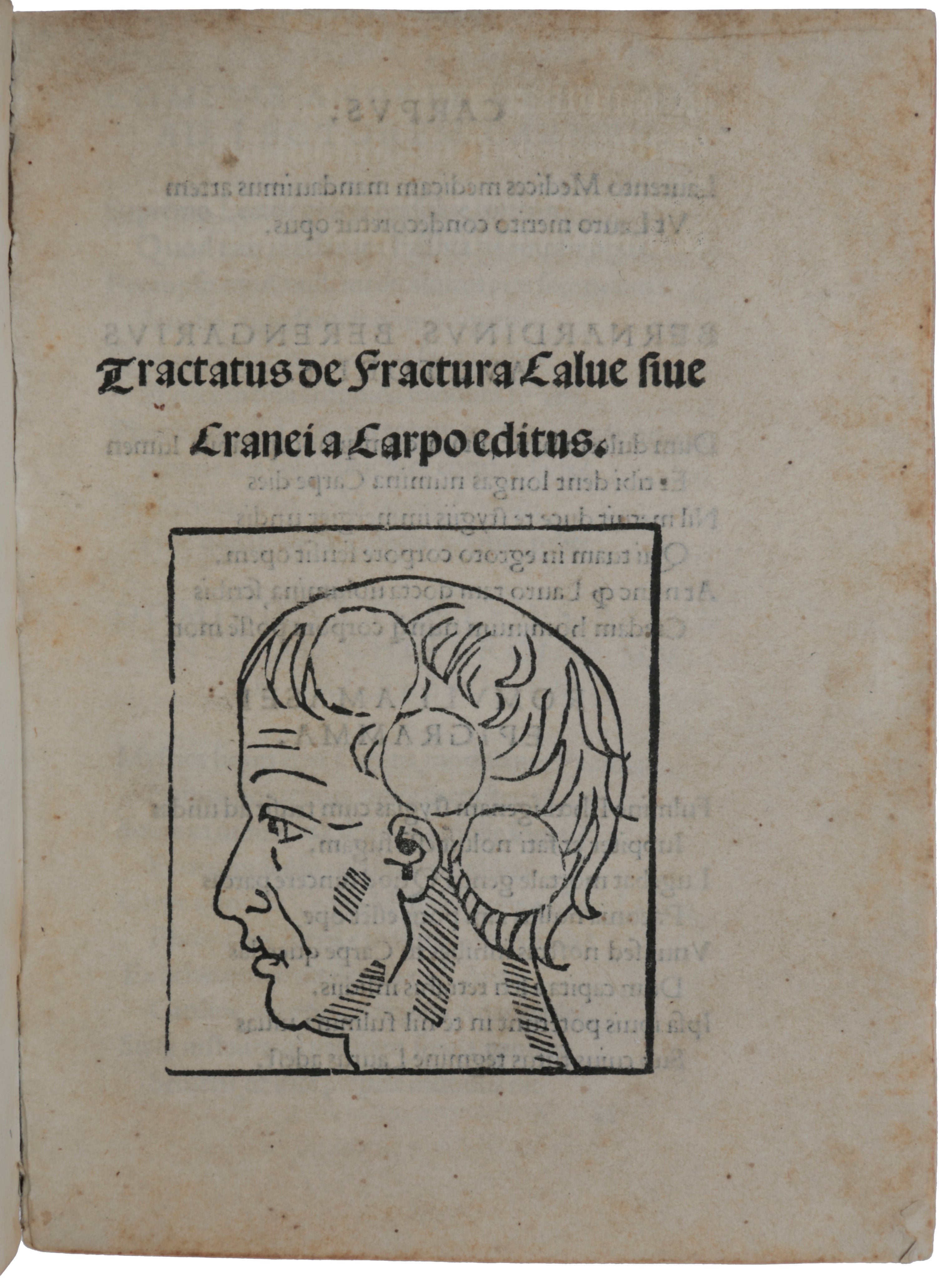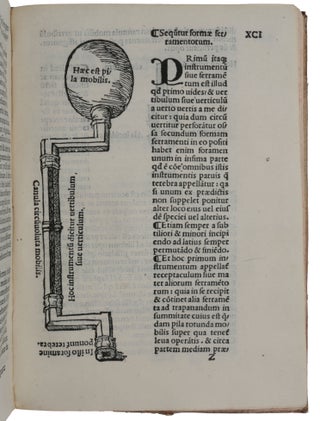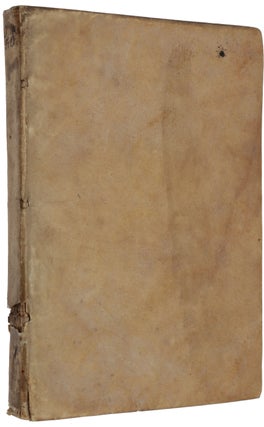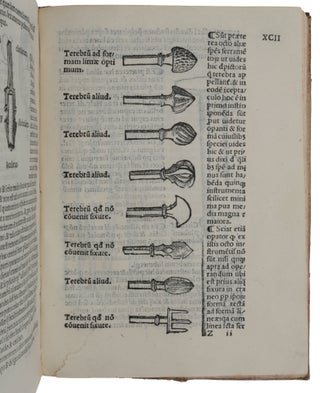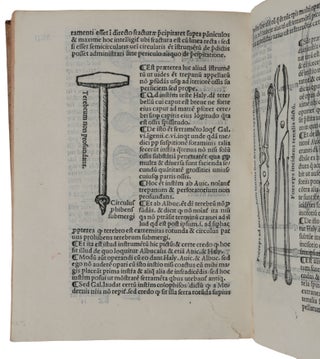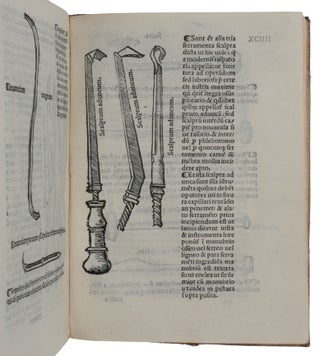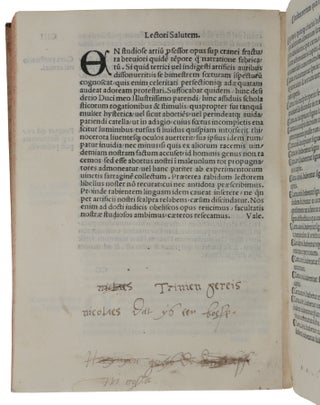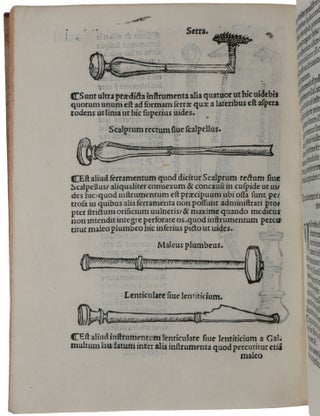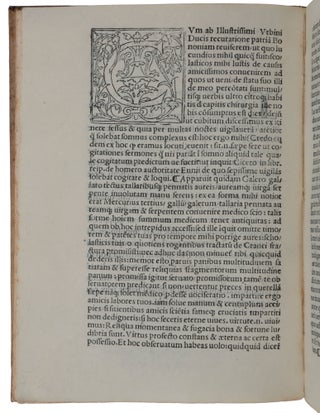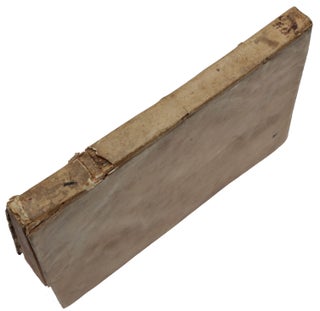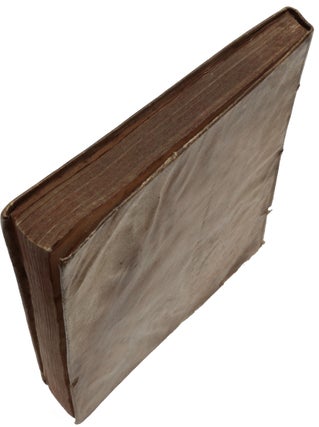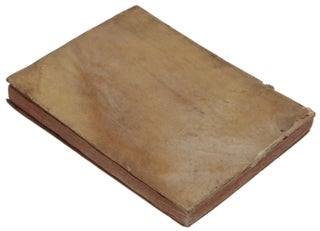Tractatus de Fractura Calve sive Cranei.
Bologna: Hieronymus de Benedictis, 1518. First edition of the first separate treatise on head injuries and their neurosurgical treatment. “The work originated in a dispute between Berengario (1460-1530) and some other physicians over the treatment of Lorenzo de’ Medici, who had suffered a skull fracture in battle. Berengario described several types of skull fractures and grouped the resulting lesions according to their symptoms, drawing from his own observations, as well as contemporary medical knowledge, to cite the relation between location and neurological effect. He also discussed prognosis, diagnosis and treatment, described the technique of craniotomy and provided detailed illustrations of contemporary neurosurgical instruments. The title illustration is a typical representation of the medieval cell doctrine, which localized mental functions in the ventricles or ‘cells’ of the brain” (Norman). “The Tractatus was written in little more than two months, soon after Berengario’s return to Bologna, and dedicated to Lorenzo de’ Medici. It opens with a short discussion of various sorts of skull fractures, followed by a grouping of the consequent lesions according to their symptoms. This is the most interesting and valuable portion of the work, for Berengario was able to cite from contemporary knowledge or from his own direct observation the relationship between the location of the lesions and the resulting neurological effects. Next, he discusses prognosis, diagnosis, treatment, the instruments to be employed, and the technique of craniotomy. Berengario’s book was the most original neurosurgical treatise until then and was not surpassed until the appearance of Ambroise Paré’s similar work in 1562, in which Paré expressed his appreciation of his predecessor’s efforts and made use of them” (DSB). “Berengario da Carpi was one of the most famous physicians of the 16th century, a recognized master of anatomy and surgery, an emblematic ‘Renaissance man’ who combined his medical experience and engineering knowledge to design new surgical instruments, and effectively used the arts of writing and drawing to describe state-of-the-art medicine and provide illustrations of anatomical structures. His greatest contribution to medicine was to write the most important work on craniocerebral surgery of the 16th century, the Tractatus de Fractura Calvae sive Cranei (‘Treatise on Fractures of the Calvaria or Cranium’), in which he described an entire set of surgical instruments to be used for cranial operations to treat head traumas that became a reference for later generations of physicians. This was a systematic treatise covering the mechanisms, classification, and medical and surgical treatment of head traumas, and can be considered a milestone in the history of neurotraumatology” (Di Ieva et al.). ABPC/RBH lists four complete copies. “In modern terms, we would say that the Treatise on Fractures of the Calvaria or Cranium deals with the physiopathology, diagnosis, treatment, and prognosis of head injuries. It is essentially based on Berengario’s personal experience, although it is presented as a true textbook complete with the most learned references and controversies, and cites many classic and medieval writers such as Hippocrates, Plato, Aristotle, Galen, Paul of Aegina, Cicero, Virgil, Seneca, Celsus, Avicenna, Abulcasis, Lanfranc, and many others. The book is divided into two parts: the first describes the causes of head injuries and proposes a classification system that is intended to be useful in everyday practice, whereas the second concentrates on symptoms, prognostic data, and treatment. “According to Berengario, the ‘broken continuity of the head’ has intrinsic and extrinsic causes, with the latter divided into three distinct types: cutting objects (incision, according to Celsus’ definition), contusing objects, and perforating objects. In proposing his classification, Berengario discusses many classic references (Avicenna, Haly Abbas, Celsus) and adds a number of examples based on his own personal experience … “A number of his ‘case reports’ include many observations deduced from patients who died as a result of head traumas, and he also very accurately described subdural and epidural hematomas, contrecoup lesions, and subdural empyema. “One chapter is dedicated to describing the signs of a cranial lesion, which may also occur without bone fracture (brain concussion): redness of the eyes, bilious vomiting, loss of speech, impaired vision, vertigo, fever, vomiting, falling down, and ‘stupor of mind.’ In the presence of these signs, Berengario suggested careful inspection and palpation because, as in the case of capillary fractures, the bone is folded or depressed inwards and ruptured in contact with the dura mater, but not toward the pericranium in the presence of intact skin. The description of the signs occurring in patients following concussion is very exhaustive, and some distinction is made concerning the neurological signs observed depending on whether the membranes (meninges) are intact or lesioned. It is interesting to note that Berengario wrote that a meningeal lesion causes persistent head pain and ‘quite active vomiting of bile’ because of a possible ‘transfer of pain from the brain to the stomach by means of prominent descending nerves.’ Eye redness was explained on the grounds of the anatomical connection between the tunic of the eyes and the membranes of the brain. “At a time when only two meningeal layers were recognized, Berengario rightly noted that injury of the ‘pia mater’ could be much more serious than that of the dura mater, and that some patients may be affected by ‘spasms’ (seizures) and paralysis on the contralateral side. Apoplexy occurred because the pus stopped in the brain ventricles, in the same way as ‘the pain of the heart produces syncope.’ Following a systematic review of the signs related to epidural or subdural injuries, Berengario spoke about his experience of the possibility of intra- parenchymal damage with symptoms similar to those associated with an injury to the pia mater. “Head injuries could also cause deficits of the ‘seven’ pairs of cranial nerves (according to Galen; the current classification of 12 pairs was proposed by Soemmering in 1778). Fever could be due to ‘bloody pus descending through the pores of the cranium above or upon the membranes.’ Throughout the history of medicine, the treatment of pus abscesses has been considered particularly important, and Berengario dedicated a whole chapter to what he rightly considered to be the main cause of ‘corruption and putrefaction of organs,’ and the main cause of death. “He also pointed out that head injuries should be treated as soon as possible (if possible, within the first hour) so as not to “prolong the illness” and, especially, because patients ‘had little sensation’ to surgery in that critical time. At a time when surgery was performed on awake patients, it was important to treat wounds aggressively and immediately because ‘once the patient is dead no assistance will be of value.’ A skin incision was considered the basic step for exposing the fracture, and trepanning, chiselling, and extracting bone fragments. “Berengario always cited anatomical references and his own dissections to explain the mechanisms of head traumas and the most appropriate way to treat fractures. He makes a long disquisition on the adherence of the dura mater to the internal tabula of the cranium, which includes examples to show that the dura does not adhere more strongly at the sutures (as had been suggested by many previous physicians); on the basis of his dissections of fetal cadavers, he rightly argued that this may be related to age. Among other explanations of subdural hematomas, Berengario did not correctly evaluate the mechanical properties of the blood separating the dura from the endocranium because he believed that a process of putrefaction was necessary to weaken and erode the ‘ligaments’ attaching the bone to the membranes; in his opinion, this separation also explained the change in color that sometimes affects traumatized cranial vault bones. “Concerning the prognosis of patients affected by head traumas, Berengario suggested a series of advances, including the fact that ‘Physicians should be cautious in making a prognosis of lesion of the head because even a minor lesion can cause apprehension, first, because it occurs in the noblest member of the body and because we have seen many similar cases become dangerous.’ He prophetically considered that ‘good surgeons as well as good physicians are rare. O good gods, how many physicians and what kinds of physicians there are to be found!’ In further polemic confirmation of this phrase, he quoted Hippocrates: ‘Many call themselves surgeons but few really are surgeons.’ “Among other prognostic factors, Berengario gave much importance to the pulse and facial expressions, and there is little doubt that he recognized anisocoria (‘… one eye appears less large that the other’) as a dangerous or fatal sign. “By this point, the treatise is already and almost incredibly a highly systematic handbook in the most modern sense, but its most original part is the section dedicated to the treatment of head injuries and the necessary instruments for treatment. “Berengario described the most widely used unguents and potions in vogue at the time for the treatment of skin wounds. He was very meticulous in describing medicines (egg yolk, chicken fat, rose oil, herbal concoctions, if possible prepared during the year of use to reduce the risk of harm) and bandages, because he shared the view expressed by Lanfranc of Milan approximately two centuries earlier that more patients were likely to be cured by medicine than by trepanning. Certainly, the most striking unguent he described is mumia, a mixture of dried human flesh to be applied to a wound continuously for 8 days, and he also revealed the secret ingredients of the potion successfully used by his father for many years, a wax unguent made of turpentine, malmsey wine, pine resin, white wax, mumia, human breast milk, and a number of distinct herbs. “Special attention was given to convalescence and nutrition during convalescence, with a series of suggestions considered fundamental for the process of recovery (ranging from the quality of the air in different Italian towns to the position to take in bed, and from diet to sexual behavior). Like previous authors, Berengario banned coitus, which was considered very harmful to people with head lesions because ‘the humors are agitated and set in motion toward the upper part of the body and can cause abscess’ and ‘coitus makes the humors ebullient and sets them into motion, crushes, suffocates, and weakens bodily force, is harmful to the stomach and its connection with the head, renders the entire body cold, weak, and bloodless’ (it was believed at the time that sperm came from the veins around the ears through the mediation of the brain). “It is worth noting that Berengario gave so many suggestions to his students because ‘a physician is not a carpenter but works with the human body; he does not work with stone or leather … If imperfect handling occurs in a human being the individual is destroyed and cannot ever be restored.’ He also took care of a patient’s ‘psychological’ status by suggesting the need to avoid anger, fear, sadness, and fury to ensure a full recovery. “When introducing the surgical part of the book, Berengario talks about the ‘manual operation … as the difficult, great, and almost horrendous … the ultimate instrument of medicine.’ After discussing the timing of surgery, describing further case histories, and providing some technical notes about the amount of bone to be removed, Berengario meticulously characterizes the surgical instruments required. Berengario believed that the instruments used to trepan and treat the skull injury of Lorenzo de’ Medici were wrong and that he was restored to health ‘with the assistance of the grace of God and medical skill.’ It is not known whether Berengario actually invented any instrument, but he encouraged the use of those that already existed and possibly made some suggestions and improvements. In particular, he provided the first didactic description, illustrated by some very clear and useful drawings, of the complete corpus instrumentorum that every ‘neurosurgeon’ should have. These were categorized into trepanning and perforating devices, elevators, extractors, and chisels, and illustrated in a sort of catalog that specified the exact terminology to be used for each. “For the first time in the medical literature, he shows a drill consisting of a rotating handle (vestibulum or verticulum), a mobile wooden ball to be held in the surgeon’s left hand (pila rotuna mobilis), a mobile crank for transferring circular movement (cannula mobilis), and drill bits for cutting and rasping (terebra). It is very interesting to note the introduction of interchangeable cranial drill bits and a ‘brace’ (receptacle) or ‘mother of the other tools because it receives into itself others for trepanning,’ thus making it the ancestor of the modern instrument. The terebra had different shapes and sizes based on specific anatomical and traumatological considerations, and it is striking to see how similar some of them are to those used in modern neurotraumatology. “The terebrum canulatum designed by Berengario had a circular toothed crown with a central pin (aculeus) to engage the bone more easily, and two lateral cutting wings (alae). After penetrating more than half of the bone thickness, another instrument without an aculeus could be used to avoid puncturing the dura. Berengario thus distinguished a masculine version with, and a feminine version without the cutting pin at the end, to be used in different anatomical situations or on the basis of the experience of the surgeon. All of these bits were used to perforate the bone and reach the meninges, but another instrument previously described in classic texts (particularly by the ‘Prince’ Avicenna) was called the terebellum or trepanum non profundans, and was designed to go less deeply into the interior surface of the bone, thus more safely avoiding any penetration of the dura mater and/or brain. “Two different forceps are also illustrated: one for cutting bone (very useful for completing a craniotomy quickly) and the other, called the tenalia or serpentina, ‘for seizing and extracting arrows, spearheads, thorns, bones, and such extraneous objects which have become lodged in the head or elsewhere.’ The elevatorium magnum and elevatorium parvum are two differently sized instruments with different shapes that were used to lift skull fragments and cut bones. The need to penetrate fracture lines was satisfied by four rasps (ras patoria or scalpra), of which the scalpellus ‘is ideal when the bones are stony hard and into which other tools cannot penetrate because of the narrow orifice of the wound, especially when the physician does not intend to perforate the bone completely.’ “Another instrument he described was the lenticulare or lentiticium, much praised by Galen, ‘which is also struck by a lead hammer [Maleus plumbeus] so as to produce less noise thanks to which the brain of the patient is less disturbed’ (although cotton or wool was used to plug the patient’s ears and reduce the noise). This was considered a very useful means of leveling the roughness of the bones and avoiding membrane injury. “In addition to describing the manufacture of these tools, Berengario pointed out that they should be extremely sharp and made of Indian iron ‘in order to cut easily without disturbing the brain of the patient.’ In line with some of the principles still used in neurosurgery, Berengario confirmed Abulcasis’ suggestion to operate in two different ways: to treat the fractures directly by gently removing bone fragments, or to perforate all around the fracture to perform a kind of perilesional craniotomy. Finally, he suggested which instruments should be used depending on the type of fracture, and also recommended the use of at least two assistants, not only to help the surgeon, but also to hold the patient down. “Berengario is often pedantic in describing surgical techniques and quoting references because (citing Seneca and Galen) he believed that ‘a repeated discussion is helpful because it is more easily committed to memory.’ During surgery, cauterization was performed by means of manual compression and the application of ‘egg and coagulating powders’ (the use of ligatures was not suggested until some decades later by Ambroise Parè). Post-operative care (changing medications and dressings, and checking that no pus was retained) was considered very important for surgical success; however, patients were to be advised to confess ‘their sins to God … since the illness is often produced by reason of those sins’” (Di Ieva et al.). Garrison-Morton-Norman 4850.2; Norman 186; Putti, pp. 136-37. Di Ieva et al., ‘Berengario da Carpi: a pioneer in neurotraumatology,’ Journal of Neurosurgery 114 (2011), pp. 1461-70.
4to (196 x 144 mm), ff, [i-x], xi-cv, [1], Roman type, title in gothic, anatomical woodcut of the cranium on title, 21 woodcut illustrations of surgical instruments, two large woodcut initials of Renaissance ornament, and numerous other smaller initials. Contemporary vellum with manuscript title to spine (spine worn at foot and with small piece missing).
Item #5182
Price: $80,000.00

